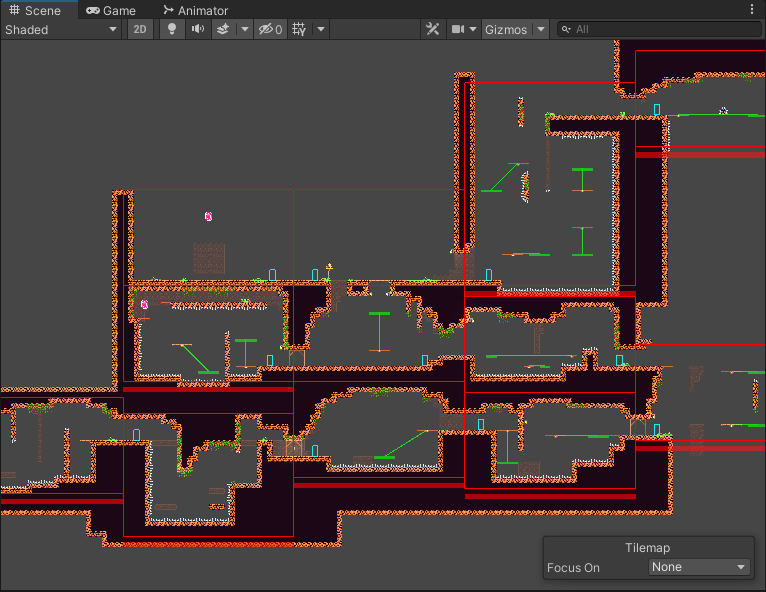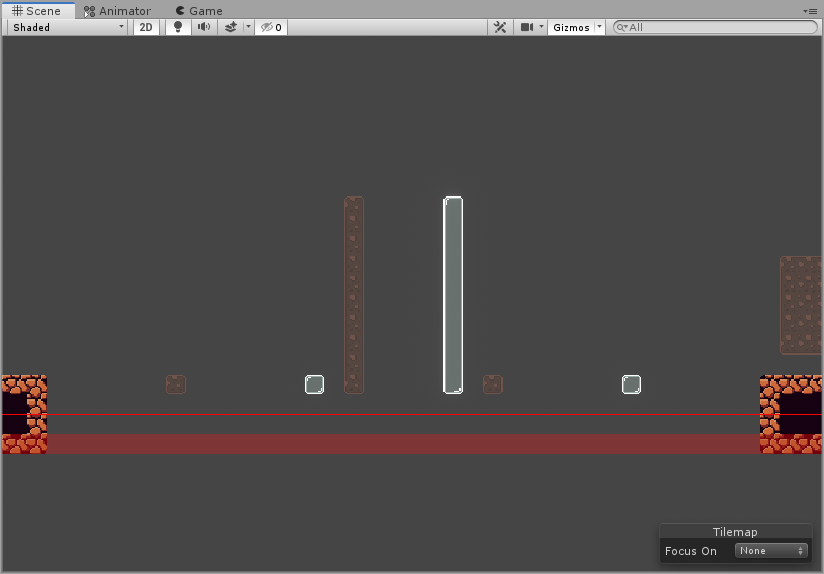Design decisions behind Shimmer Of Light
Inspired by platformers like Celeste, the idea behind Shimmer Of Light was to make a responsive, quick pace platformer with a high skill ceiling. With one special ability that would allow interesting interactions between mechanics. Right away from the start it was certain that this ability would be to bring background elements to the foreground to use them as platforms. Unity was chosen for this project, becuase of its great support for 2D projects.
Movement
Naturally, with such a game, movement was the first thing to get right. I started with some basic character animations, since I wanted to have a visual anchor while programming the movement. With that done I started the actual movement code. While Unity's rigidbody is great, I find it very unsatisfying for movement. Because of this I avoided using forces and instead set the velocity of the character directly, which meant acceleration had to be finely controlled via code. I also programmed my own air drag and friction, since Unity's solution didn't give me enough control. This lead me to a movement system which I could adjust very finely.
Some measures were also taken to support the player:
-The charcters jump is executed even if the player pressed the button a few ms before landing.
-A boost jump is also done if the player pressed the jump button even after a platform stopped moving.
-And if the player switches the daytime while simultaneously jumping the two actions are executed in the right order, which allows jumping out of a 2 block high dirt prison (this is a high skill level move and is not necessary to complete the game, only for collectibles).
The camera dilemma
One of the earlier problems I encountered is where the camera should go. The game is fairly far zoomed in, which doesn't leave much space for the intended fast paced platforming. A simple solution would be to contain every level to a single screen. This , however, would feel claustrophobic and would have restricted the level design greatly. Another simple solution would be to just have the camera follow the player . This unfortunately leads to a number of problems: The level designer would never know what the player actually sees, since the player could be anywhere, which hinders the level designer to lead the player to the exit or the solution. Another problem with this is that platforming is really hard and feels inconsistend with a moving camera.
So I opted for a hybrid solution, which is also very flexible for level iteration: The levels are contained in a screen box which has a set size. The camera can move freely in said screen boxes, but tries to keep the player centered . This was a great solution, in level design you always know where the camera will be and you have the flexibility to create long, big levels. Additionaly camera smoothing was implemented. This gives greater orientation, especially when moving between screen boxes.
Here's how that looks in Unity:

Levels
Once I was happy with the movement, the next step was to make some levels. I had some ideas in mind, aswell as on paper. With those in mind I quickly made some sprite sheets and started proptotyping.

Above is probably one of the first levels that I had in mind. The dirt tiles have their collision enabled at night and the glass tiles have their collision enabled at day. This makes the player have to not only jump precisely, but also switch the daytime at the right moment.
There is one problem with levels like this one: It is way too hard for a beginner. So I made a list of all the mechanics and interactions between them and rated them on how hard they were. Based on that rating, I crafted levels which would teach the player each skill they needed chronologically. Each mechanic is introduced slowly and with a low risk of death, so that the player can experiment. Then the mechanic is explored and first interactions with other mechanics are introduced. Lastly the player's skills are tested with a high risk vs reward. This feels great and based on playtesters experiences it feels rewarding, which is exactly what I had in mind.
Happy Accidents
Unitys's 2D collision system just prevents any rigidbody to cross its outline, which means you can enter the collision volume and move inside of it. I could have just killed the player once that happened, but this would be very annoying and unituitive to play. So I left it in place and integrated it into the game. This lead to some interesting levels where the playing person has to switch up his approach to the game. It also brought about my favourite mechanic; The dirt prision as mentioned above.

To be able to escape such a prision some extra measures had to be taken in the movement code, as explained above. With the extra measures taken to ensure consistenty when jumping out of a dirt prision, this also was integrated into the game. These are optional and not part of the main game, but are great for veteran platformers and speedrunners alike.
Get Shimmer Of Light
Shimmer Of Light
A high skill ceiling 2D platformer. (Unity)
| Status | In development |
| Author | Reduxen |
| Genre | Platformer, Puzzle |
| Tags | 2D, Speedrun |

Leave a comment
Log in with itch.io to leave a comment.